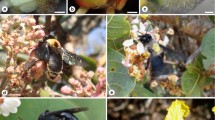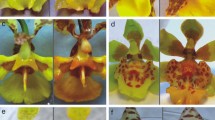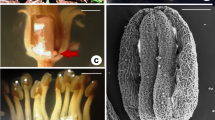Abstract
Most Neotropical Malpighiaceae species are characterized by having zygomorphic flowers and oil glands in the sepals called elaiophores; these floral characteristics are associated with a particular pollination syndrome through oil-collecting bees. This work proposes a study about the structural characteristics of elaiophores in 18 species of Malpighiaceae present in Argentina. The main objectives are to describe the morphology and anatomy of the elaiophores, to detect variation in the number of glands, to compare similarities or differences in elaiophores of species belonging to different lineages, and to know about the potential pollinators and their association with the structural traits of the elaiophores. The morphology and the anatomy were studied using traditional methods of scanning electron and bright-field microscopes. Field trips were carried out to capture oil-collecting bee species on flowers, in different natural populations. Different measurements were taken in the flowers, elaiophores, and oil-collecting bees and were statistically analyzed. Although elaiophores showed a common pattern, some particularities in number, morphology, and anatomy were detected; few of these seem to be restricted to some groups of species phylogenetically related. As regards pollinators, a positive tendency was observed between the size of the flowers, elaiophores, and oil-collecting bees. However, the thickness of the cuticle presented a negative association with the size of the elaiophore and consequently with the floral diameter, which could be presumably related to the foraging behavior and/or the structure of oil-collecting apparatus of the bee species.







Similar content being viewed by others
References
Aguiar CML (2003) Utilização de recursos florais por abelhas (Hymenoptera, Apoidea) em uma área de Caatinga (Itatim, Bahia, Brasil). Rev Bras Zool 20:457–467. https://doi.org/10.1590/S0101-81752003000300015
Aguiar AJ, Melo GA, Vasconcelos TN, Gonçalves RB, Giugliano L, Martins AC (2020) Biogeography and early diversification of Tapinotaspidini oil-bees support presence of Paleocene savannas in South America. Mol Phylogenet Evol 143:106692. https://doi.org/10.1016/j.ympev.2019.106692
Albuquerque PMC, Mendonça JAC (1996) Anthophoridae (Hymenoptera: Apoidea) e flora associada em uma formação de Cerrado no Município de Barreirinhas, MA, Brasil. Acta Amazon 26:45–54. https://doi.org/10.1590/1809-43921996261054
Albuquerque PMC, Rêgo MMC (1989) Fenologia das abelhas visitantes de murici (Byrsonima crassifolia Malpighiaceae). Bol Mus Para Emílio Goeldi 5:163–178
Aliscioni SS, Torretta JP (2017) Malpighiaceae. In: Zuloaga FO, Belgrano MJ (eds) Flora Vascular de la República Argentina, 17. Estudio Sigma S.R.L., Buenos Aires, pp 163–205
Aliscioni SS, Gotelli M, Torretta JP (2019) Gynoecium with carpel dimorphism in Tricomaria usillo, comparison with other genera of the Carolus clade (Malpighiaceae). Protoplasma 256:1133–1144. https://doi.org/10.1007/s00709-019-01373-3
Anderson WR (1979) Floral conservatism in Neotropical Malpighiaceae. Biotropica 11:219–223. http://hdl.handle.net/2027.42/62182
Anderson WR (1990) The origin of the Malpighiaceae, the evidence from morphology. Mem NY Bot Gard 64:210–224
Anderson WR, Corso S (2007) Psychopterys, a new genus of Malpighiaceae from Mexico and Central America. Contrib Univ Michigan Herb 25:113–135
Anderson WR, Anderson C, Davis CC (2006) Malpighiaceae http://herbarium.lsa.umich.edu/malpigh/index.html. Accessed 20 December 2019
Araújo JS, Meira RMSA (2016) Comparative anatomy of calyx and foliar glands of Banisteriopsis CB Rob. (Malpighiaceae). Acta Bot Brasil 30:112–123. https://doi.org/10.1590/0102-33062015abb0248
Barros MAG (1992) Fenologia da floração, estratégias reprodutivas e polinização de espécies simpátricas do gênero Byrsonima Rich (Malpighiaceae). RevBrasBiol 52:343–353
Cameron KM, Chase MW, Anderson WR, Hills HG (2001) Molecular systematics of Malpighiaceae: evidence from plastid rbcL and matK sequences. Am J Bot 88:1847–1862. https://doi.org/10.2307/3558361
Cane JH (1987) Estimation of bee size using intertegular span (Apoidea). J Kansas Entomol Soc 60:145–147
Cappellari SC, Haleem MA, Marsaioli AJ, Tidon R, Simpson BB (2011) Pterandra pyroidea: a case of pollination shift within Neotropical Malpighiaceae. Ann Bot 107:1323–1334. https://doi.org/10.1093/aob/mcr084
Carvalho PDD, Borba EL, Lucchese AM (2005) Variation in the number of glands and oil production in flowers of Stigmaphyllon paralias A. Juss. (Malpighiaceae). Acta Bot Brasil 19:209–214
Castro MA, Vega AS, Múlgura ME (2001) Structure and ultrastructure of leaf and calyx glands in Galphimia brasiliensis (Malpighiaceae). Am J Bot 88:1935–1944. https://doi.org/10.2307/3558420
Cocucci AA, Holgado A, Antón A (1996) Estudio morfológico y anatómico de los eleóforos pedicelados de Dinemandra ericoides, Malpighiaceae endémica del desierto de Atacama, Chile. Darwiniana 34:183–192
Cosacov A, Cocucci AA, Sérsic AN (2012) Variación geográfica de la recompensa floral de Calceolaria polyrhiza (Calceolariaceae): Influencia de factores bióticos y abióticos. Bol Soc Argent Bot 47:363–373
Cote GG, Gibernau M (2012) Distribution of calcium oxalate crystals in floral organs of Araceae in relation to pollination strategy. Am J Bot 99:1231–1242. https://doi.org/10.3732/ajb.1100499
Cunha R, Blochtein B (2003) Bionomia de Monoeca xanthopyga Harter-Marques, Cunha & Moure (Hymenoptera, Apidae, Tapinotaspidini) no Planalto das Araucárias, Rio Grande do Sul, Brasil. Rev Bras Zool 20:107–113. https://doi.org/10.1590/S0101-81752003000100013
da Rocha-Filho LC, Melo GA (2011) Nesting biology and behavioural ecology of the solitary bee Monoeca haemorrhoidalis (Smith) and its cleptoparasite Protosiris gigas Melo (Hymenoptera: Apidae: Tapinotaspidini; Osirini). J Nat Hist 45:2815–2840. https://doi.org/10.1080/00222933.2011.616271
Davis CC, Anderson WR (2010) A complete generic phylogeny of Malpighiaceae inferred from nucleotide sequence data and morphology. Am J Bot 97:2031–2048. https://doi.org/10.3732/ajb.1000146
Davis CC, Anderson WR, Donoghue MJ (2001) Phylogeny of Malpighiaceae: evidence from chloroplast ndhF and trnL–F nucleotide sequences. Am J Bot 88:1830–1846. https://doi.org/10.2307/3558360
Davis CC, Bell CD, Mathews S, Donoghue MJ (2002) Laurasian migration explains Gondwanan disjunctions: evidence from Malpighiaceae. Proc Natl Acad Sci USA 99:6833–6837. https://doi.org/10.1073/pnas.102175899
Davis CC, Schaefer H, Xi Z, Baum DA, Donoghue MJ, Harmon LJ (2014) Long-term morphological stasis maintained by a plant–pollinator mutualism. Proc Natl Acad Sci USA 111:5914–5919. https://doi.org/10.1073/pnas.1403157111
Evert RF (2006) Esau’s plant anatomy: meristems, cells, and tissues of the plant body: their structure, function, and development. John Wiley & Sons, New York
Gaglianone MC (2000) Interações de Epicharis (Apidae, Centridini) e flores de Malpighiaceae em um ecossistema de cerrado. Anais Do Encontro Sobre Abelhas 4:246–252
Gaglianone MC (2003) Abelhas da tribo Centridini na Estação Ecológica de Jataí (Luiz Antônio, SP): composição de espécies e interações com flores de Malpighiaceae. Apoidea Neotropica 90:279–284
Gates B (1982) Banisteriopsis, Diplopterys (Malpighiaceae). Flora Neotrop 30:1–237
Giannini TC, Pinto CE, Acosta AL, Taniguchi M, Saraiva AM, Alves dos Santos I (2013) Interactions at large spatial scale: the case of Centris bees and floral oil producing plants in South America. Ecol Modelling 258:74–81. https://doi.org/10.1016/j.ecolmodel.2013.02.032
Gimenes M, Oliveira P, Almeida GF (2002) Estudo das interações entre as abelhas e as flores em um ecossistema de restinga na Bahia. Anais Do Encontro Sobre Abelhas 5:117–121
Gottsberger G (1986) Some pollination strategies in neotropical savannas and forests. Plant Syst Evol 152:29–45. https://doi.org/10.1007/BF00985349
Harrell Jr FE (2018) Hmisc: Harrell Miscellaneous. R package version 4.1–1. https://CRAN.R-project.org/package=Hmisc
Machado IC (2002) Flores de óleo e abelhas coletoras de óleo floral: conceitos, distribuição e revisão. Anais Do Encontro Sobre Abelhas 5:129–135
Martins A, Aguiar JC, Alves dos Santos I (2013) Interaction between oil-collecting bees and seven species of Plantaginaceae. Flora 208:401–411. https://doi.org/10.1016/j.flora.2013.07.001
Martins AC, Melo GA (2016) The New World oil collecting bees Centris and Epicharis (Hymenoptera, Apidae): molecular phylogeny and biogeographic history. Zool Scr 45:22–33. https://doi.org/10.1111/zsc.12133
Martins AC, Melo GA, Renner SS (2015) Gain and loss of specialization in two oil bee lineages, Centris and Epicharis (Apidae). Evolution 69:1835–1844. https://doi.org/10.1111/evo.12689
Michener CD (2007) The bees of the world. 2nd ed. Johns Hopkins, Baltimore
Neff JL, Simpson BB (1981) Oil-collecting structures in Anthophoridae (Hymenoptera): morphology, function, and use in systematics. J Kansas Entomol Soc 54:95–123
Neves EL, Viana BF (2001) Ocorrência de Epicharis bicolor Smith (Hymenoptera: Apidae: Centridini) nas caatingas da margem esquerda do médio Rio São Francisco, Bahia. Neotrop Entomol 30:735–736. https://doi.org/10.1590/S1519-566X2001000400034
Pedro SRM (1994) Interações entre abelhas e flores em uma área de cerrado no NE do Estado de São Paulo: abelhas coletoras de óleo (Hymenoptera: Apoidea: Apidae). Anais Do Encontro Sobre Abelhas 1:243–255
Possobom CCF, Guimarães E, Machado SR (2015) Structure and secretion mechanisms of floral glands in Diplopterys pubipetala (Malpighiaceae), a neotropical species. Flora 211:26–39. https://doi.org/10.1016/j.flora.2015.01.002
Possobom CCF, Machado SR (2017) Elaiophores: their taxonomic distribution, morphology and functions. Acta Bot Brasil 31:503–524. https://doi.org/10.1590/0102-33062017abb0088
Possobom CC, Machado SR (2018) Elaiophores in three Neotropical Malpighiaceae species: a comparative study. Plant Syst Evol 304:15–32. https://doi.org/10.1007/s00606-017-1443-6
Quinn GP, Keough MJ (2002) Experimental design and data analysis for biologists. Cambridge University Press, Cambridge
R Core Team (2017) R: A language and environment for statistical computing. R Foundation for Statistical Computing, Vienna, Austria. https://www.R-project.org/
Raw A (1979) Centris dirrhoda (Anthophoridae), the bee visiting West Indian cherry flowers (Malpighia punicifolia). Revista Biol Trop 27:203–205
Rebêlo JMM (1995) Espécies de Anthophoridae (Hymenoptera, Apoidea) e sua associação com flores, numa área restrita da Ilha de São Luis-MA. Brasil Bol Mus Para Emílio Goeldi 11:105–124
Ren MX, Zhong YF, Song XQ (2013) Mirror-image flowers without buzz pollination in the Asian endemic Hiptage benghalensis (Malpighiaceae). Bot J Linn Soc 173:764–774
Renner SS, Schaefer H (2010) The evolution and loss of oil-offering flowers: new insights from dated phylogenies for angiosperms and bees. Philos Trans R Soc Lond B Biol Sci 365:423–435Roig Alsina A (2000) Claves para las especies argentinas de Centris (Hymenoptera, Apidae), con descripción de nuevas especies y notas sobre distribución. Rev Mus Argent Cienc Nat, Ns 2:171–193
Roig-Alsina A (2000) Claves para las especies argentinas de Centris (Hymenoptera, Apidae), con descripción de nuevas especies y notas sobre distribución. Rev Mus Argentino Cienc Nat ns 2:171–193
Rozen JG, Melo GA, Aguiar AJC, Alves dos Santos I (2006) Nesting biologies and immature stages of the tapinotaspidine bee genera Monoeca and Lanthanomelissa and of their osirine cleptoparasites Protosiris and Parepeolus (Hymenoptera: Apidae: Apinae). Am Mus Novitates 3501:1–60
Sazima M, Sazima I (1989) Oil-gathering bees visit flowers of eglandular morphs of the oil-producing Malpighiaceae. Bot Acta 102:106–111. https://doi.org/10.1111/j.1438-8677.1989.tb00073.x
Sérsic AN (2004) Pollination biology in the genus Calceolaria L. (Calceolariaceae). Stapfia 82:1–121
Sigrist MR, Sazima M (2004) Pollination and reproductive biology of twelve species of Neotropical Malpighiaceae: stigma morphology and its implications for the breeding system. Ann Bot 94:33–41. https://doi.org/10.1093/aob/mch108
Simpson BB (1989) Pollination biology and taxonomy of Dinemandra and Dinemagonum (Malpighiaceae). Syst Bot 14:408–426
Simpson BB, Neff JL (1983) Evolution and diversity of floral rewards. Handbook of experimental pollination biology pp 142–157
Souto LS, Oliveira DMT (2014) Seed development in Malpighiaceae species with an emphasis on the relationships between nutritive tissues. C R Biol 337:62–70. https://doi.org/10.1016/j.crvi.2013.11.001
Subramanian RB, Arumugasamy K, Inamdar JA (1990) Studies in the secretory glands of Hiptage sericea (Malpighiaceae). Nord J Bot 10:57–62. https://doi.org/10.1111/j.1756-1051.1990.tb01753.x
Tadey M (2012) Reproductive biology of Monttea aphylla (Scrophulariaceae). Austral J Bot 59:713–718. https://doi.org/10.1071/BT10282
Teixeira LAG, Machado IC (2000) Sistema de polinização e reprodução de Byrsonima sericea DC (Malpighiaceae). Acta Bot Brasil 14:347–357. https://doi.org/10.1590/S0102-33062000000300011
Torretta JP, Aliscioni SS, González Arzac A, Avalos AA (2017) Is the variation of floral elaiophore size in two species of Stigmaphyllon (Malpighiaceae) dependent on interaction with pollinators? Plant Ecol Divers 10:403–418. https://doi.org/10.1080/17550874.2018.1434567
Torretta JP, Roig Alsina A (2016) First report of Monoeca in Argentina, with description of two new species (Hymenoptera: Apidae). J Melittol 59:1–12. https://doi.org/10.17161/jom.v0i59.5031
Vivallo F (2013) Revision of the bee subgenus Centris (Wagenknechtia) Moure, 1950 (Hymenoptera: Apidae: Centridini). Zootaxa 3683:501–537. https://doi.org/10.11646/zootaxa.3683.5.1
Vivallo F (2020) The species of the bee genus Centris of the “hyptidis group” revisited with the description of Centris (Anisoctenodes) new subgenus (Hymenoptera: Apidae: Centridini). Eur J Taxon 709:1–17. https://doi.org/10.5852/ejt.2020.709
Vogel S (1974) Ölblumen und ölsammelnde Bienen. Abhandlungen Akademie Wissenschaften Mathematisch-Naturwissenschaften Klasse. Trop Subtrop Pflanzenwelt 7:283–547
Vogel S (1988) Die Ölblumensymbiosen parallelismus und andere Aspekt ihrer Entwicklung in Raum und Zeit. J Zool Syst Evol Res 26:341–362
Vogel S (1990) History of the Malpighiaceae in the light of pollination ecology. Mem NY Bot Gard 55:130–142
Vogel S, Machado ICS (1991) Pollination of four sympatric species of Angelonia (Scrophulariaceae) by oil-collecting bees in NE Brazil. Plant Syst Evol 178:153–178
Zarlavsky GE (2014) Histología Vegetal: técnicas simples y complejas. Sociedad Argentina de Botánica, Ciudad Autónoma de Buenos Aires
Acknowledgements
We thank M. Gotelli, R. Saurral, and A. Torretta for comments on the manuscript and the English revision, A. Avalos for photographs of Epicharis and Monoeca, G. Zarvlasky for technical assistance, and two anonymous reviewers for the constructive comments to previous draft. To the Administración de Parque Nacionales (Regional NEA), the Ministerio de Ecología y Recursos Naturales Renovables, province of Misiones, and the Dirección de Áreas Naturales Protegidas, Organismo Provincial para el Desarrollo Sostenible, province of Buenos Aires, for permission to conduct part of this study in protected areas.
Funding
Funding was provided by CONICET PIP 11220110100312, FONCYT PICT 2013–1867, UBACyT 20020130200203BA, 20020120100056BA, 20020170200252BA.
Author information
Authors and Affiliations
Corresponding author
Additional information
Handling Editor: Dorota Kwiatkowska
Publisher's note
Springer Nature remains neutral with regard to jurisdictional claims in published maps and institutional affiliations.
Rights and permissions
About this article
Cite this article
Aliscioni, S.S., Gomiz, N.E., Agüero, J.I. et al. Structural diversity of elaiophores in Argentine species of Malpighiaceae: morphology, anatomy, and interaction with pollinators. Protoplasma 259, 789–807 (2022). https://doi.org/10.1007/s00709-021-01699-x
Received:
Accepted:
Published:
Issue Date:
DOI: https://doi.org/10.1007/s00709-021-01699-x




